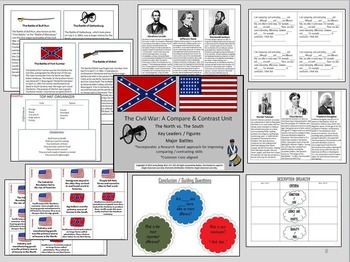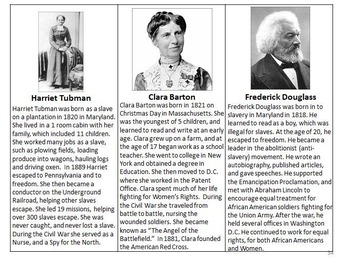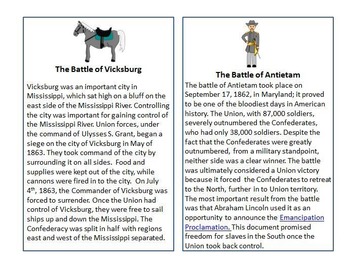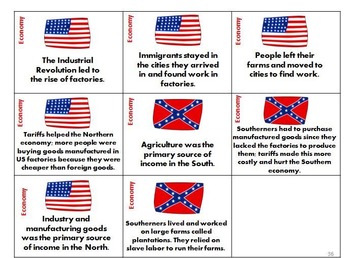Civil War Compare and Contrast Unit
Beyond Speech Therapy
656 Followers
Grade Levels
4th - 8th
Subjects
Resource Type
Standards
CCSSRL.4.9
CCSSRL.5.3
CCSSRL.5.5
CCSSRL.5.9
Formats Included
- PDF
Pages
44 pages
Beyond Speech Therapy
656 Followers
What educators are saying
I used this in my 3rd grade classroom when we were studying the Civil War. It was packed full of information! We all loved it!
Description
The Civil War Compare & Contrast Unit is designed to help support achievement of Common Core Standards by building comparison skills. It incorporates a research based strategy for developing comparing / contrasting skills, and is curriculum based. This unit focuses on ELA (English Language Arts) goals while utilizing Social Studies materials, allowing Therapists / Teachers to build skills across subject areas. It is appropriate for use with Upper Elementary and Middle School students. The resource may be used in small group, for centers based learning, and/or in resource rooms.
Activities include the following:
North vs. South: Compare and contrast the economic, geographic, and social / cultural differences of the North vs. the South during the antebellum period and throughout the Civil War
Key People: Learn about key figures during the Civil War period, including: Abraham Lincoln, Jefferson Davis, Robert E. Lee, Ulysses S. Grant, Stonewall Jackson, Harriet Tubman, Harriet Beecher Stowe, Clara Barton, Frederick Douglass, and Eli Whitney. Compare and contrast early childhood life, education, careers, motives, and traits of key figures.
Major Battles: Read about the major battles fought during the Civil War. Answer comprehension questions and discuss similarities / differences between battles, such as date, location, number of casualties, leaders, outcome, significance. Battles addressed include: Fort Sumter, Shiloh, Bull Run, Gettysburg, Vicksburg, and Antietam.
Contents: This packet includes the following materials-
Non-fiction narrative cards detailing major battles of the Civil War; includes 1 narrative for each of the following: Fort Sumter, Shiloh, Bull Run, Gettysburg, Vicksburg, and Antietam (total of 6)
Comprehension question cards for reading or listening comprehension tasks; 4 comprehension cards corresponding to each battle narrative (total of 24)
Answer keys to pair with comprehension question cards so that students can self-check their responses
Battle cards: information cards for students to fill out while reading about each battle; assists with organizing information for comparing and contrasting tasks; 4 reproducible templates
Non-fiction biography cards describing key leaders / figures during the Civil War; includes 1 narrative card for each of the following: Abraham Lincoln, Jefferson Davis, Robert E. Lee, Ulysses S. Grant, Stonewall Jackson, Harriet Beecher Stowe, Harriet Tubman, Clara Barton, and Eli Whitney.
Economic, geographic, and social / cultural cards containing facts about the antebellum North and South; sort cards on to the included sorting mats, then compare / contrast the economic, geographic, and social / cultural differences between the 2 regions that ultimately led to war; includes 8 economic, 7 geographic, and 6 social / cultural cards (total of 21)
Guidelines, Graphic Organizers, & Samples for a 4-step research-based strategy to improving comparing / contrasting skills.
Comparing & Contrasting visual strategy guide
*Curriculum Alignment: North Carolina Social Studies Curriculum includes a Unit of Study entitled, "The Civil War and Reconstruction," taught in 5th grade during the 4th quarter.
Activities include the following:
North vs. South: Compare and contrast the economic, geographic, and social / cultural differences of the North vs. the South during the antebellum period and throughout the Civil War
Key People: Learn about key figures during the Civil War period, including: Abraham Lincoln, Jefferson Davis, Robert E. Lee, Ulysses S. Grant, Stonewall Jackson, Harriet Tubman, Harriet Beecher Stowe, Clara Barton, Frederick Douglass, and Eli Whitney. Compare and contrast early childhood life, education, careers, motives, and traits of key figures.
Major Battles: Read about the major battles fought during the Civil War. Answer comprehension questions and discuss similarities / differences between battles, such as date, location, number of casualties, leaders, outcome, significance. Battles addressed include: Fort Sumter, Shiloh, Bull Run, Gettysburg, Vicksburg, and Antietam.
Contents: This packet includes the following materials-
Non-fiction narrative cards detailing major battles of the Civil War; includes 1 narrative for each of the following: Fort Sumter, Shiloh, Bull Run, Gettysburg, Vicksburg, and Antietam (total of 6)
Comprehension question cards for reading or listening comprehension tasks; 4 comprehension cards corresponding to each battle narrative (total of 24)
Answer keys to pair with comprehension question cards so that students can self-check their responses
Battle cards: information cards for students to fill out while reading about each battle; assists with organizing information for comparing and contrasting tasks; 4 reproducible templates
Non-fiction biography cards describing key leaders / figures during the Civil War; includes 1 narrative card for each of the following: Abraham Lincoln, Jefferson Davis, Robert E. Lee, Ulysses S. Grant, Stonewall Jackson, Harriet Beecher Stowe, Harriet Tubman, Clara Barton, and Eli Whitney.
Economic, geographic, and social / cultural cards containing facts about the antebellum North and South; sort cards on to the included sorting mats, then compare / contrast the economic, geographic, and social / cultural differences between the 2 regions that ultimately led to war; includes 8 economic, 7 geographic, and 6 social / cultural cards (total of 21)
Guidelines, Graphic Organizers, & Samples for a 4-step research-based strategy to improving comparing / contrasting skills.
Comparing & Contrasting visual strategy guide
*Curriculum Alignment: North Carolina Social Studies Curriculum includes a Unit of Study entitled, "The Civil War and Reconstruction," taught in 5th grade during the 4th quarter.
Total Pages
44 pages
Answer Key
N/A
Teaching Duration
N/A
Report this resource to TPT
Reported resources will be reviewed by our team. Report this resource to let us know if this resource violates TPT’s content guidelines.
Standards
to see state-specific standards (only available in the US).
CCSSRL.4.9
Compare and contrast the treatment of similar themes and topics (e.g., opposition of good and evil) and patterns of events (e.g., the quest) in stories, myths, and traditional literature from different cultures.
CCSSRL.5.3
Compare and contrast two or more characters, settings, or events in a story or drama, drawing on specific details in the text (e.g., how characters interact).
CCSSRL.5.5
Explain how a series of chapters, scenes, or stanzas fits together to provide the overall structure of a particular story, drama, or poem.
CCSSRL.5.9
Compare and contrast stories in the same genre (e.g., mysteries and adventure stories) on their approaches to similar themes and topics.





